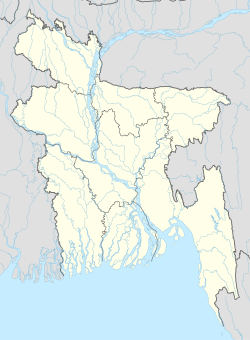Manikganj
This article's tone or style may not reflect the encyclopedic tone used on Wikipedia. (October 2024) |
Manikganj
মানিকগঞ্জ | |
|---|---|
 Darul Uloom Manikganj | |
| Coordinates: 23°51′N 90°01′E / 23.850°N 90.017°E | |
| Country | |
| Division | Dhaka |
| District | Manikganj |
| Upazila | Manikganj Sadar |
| Named after | Maharaja Manik Ram Basu[1] Sufi saint Manik Sha |
| Government | |
| • Type | Mayor–Council |
| • Body | Manikganj Municipal Corporation |
| Area | |
• Total | 2.28 km2 (0.88 sq mi) |
| Population | |
• Total | 71,698 |
| • Density | 31,000/km2 (81,000/sq mi) |
| Time zone | UTC+6 (Bangladesh Time) |
| National Dialing Code | +880 |
Manikganj is a town situated in Dhaka Division, Bangladesh. It is the headquarters of Manikganj District and Manikganj Sadar Upazila. Manikganj is a relatively pollution-free town of Bangladesh. The recent urbanization and highway built joining Dhaka and Singair Upazila has given it a good roadview and better communication. The river Padma flows beside this district and supported the flora and fauna. It connects the north-western and south-western region of Bangladesh by Paturia and Aricha ghat. It is well known for its molasses from Jhitka. Baliati Zamindari palace is a major tourist attraction. [2]
History
[edit]Manikganj was the home to the Baliati Zamindari and Zamindar family of Raja Manik Ram Basu. Manikganj is belived to have been named after Raja Manik Ram Basu.[3] Raja Manik Ram Basu was the monarch of the Hatkhola royal family, in North Calcutta. His granddaughter Princess Kalishakamini Dasi was married to Peary Charan Sarkar.[4][5][6]
-
The Manikganj Basu Zamindar Palace.
-
Maharani I of Manikganj- Maharani Soudamini Devi
List of rulers of Manikganj
[edit]| Monarch Name | Reign Period | Consort Name | Region |
|---|---|---|---|
| Maharaja Ishwar Ram Basu[7] | c. 1745–c. 1765 | Rani Soudamini Devi | Manikganj, |
| Maharaja Darpanarayan Basu[8] | c. 1765–c. 1770 | Rani Priyamvada Devi | Manikganj, |
| Maharaja Manik Ram Basu[9][10] | c. 1770–c. 1785 | Rani Indumati Devi | Manikganj, |
| Maharaja Ram Hari Basu[11] | c. 1785–c. 1789 | Rani Satyavati Devi | Manikganj |
| Maharaja Shib Narayan Basu[10] | c. 1789–c. 1797 | Rani Kamalini Devi | Manikganj |
Demographics
[edit]At the time of the 2011 census, Manikganj Paurashava had 16,459 households and a population of 71,698. 13,017 (18.16%) were under 10 years of age. Manikganj had a literacy rate of 69.10% and a sex ratio of 987 females per 1000 males.[12]
See also
[edit]- Manikganj District
- Manikganj Sadar Upazila
- List of cities and towns in Bangladesh
- Upazilas of Bangladesh
References
[edit]- ^ Mitra, Radharaman (1952). Kolikata - Darpan Parba 1. p. 275.
- ^ "Manikganj Village 's civic body". Retrieved 26 October 2019.
- ^ Mitra, Radharaman (1952). Kolikata - Darpan Parba 1. p. 275.
- ^ BeeZone (2019-07-03). Sailendra Sircar Centenary. pp. 18, 24.
- ^ Dutt, Haradhan (1978). Sekālora śikshāguru (in Bengali). Tuli-Kalama. pp. 58–60.
- ^ Sircar, Mahendranath (1914). Life of Peary Churn Sircar, a Recast. University of Michigan. pp. 19, 25.
- ^ Bose, Ramesh (1847). The Legacy of Maharaja Ishwar Ram Basu: A Historical Analysis. Calcutta: Eastern Heritage Press.
- ^ Chatterjee, Sourav (1853). "Darpanarayan Basu and the Bengal Aristocracy: Political and Social Influence". Dhaka Historical Review. 7 (2): 115–132.
- ^ Dutt, Haradhan (1978). Sekālora śikshāguru (in Bengali). Tuli-Kalama.
- ^ a b Sircar, Mahendranath (1914). Life of Peary Churn Sircar, a Recast.
- ^ Mitra, Rādhāramaṇa (1980). Kalikātā-darpaṇa (in Bengali). Subarṇarekhā. ISBN 978-81-86263-48-8.
- ^ a b "Community Tables: Manikganj district" (PDF). Bangladesh Bureau of Statistics. 2011.







